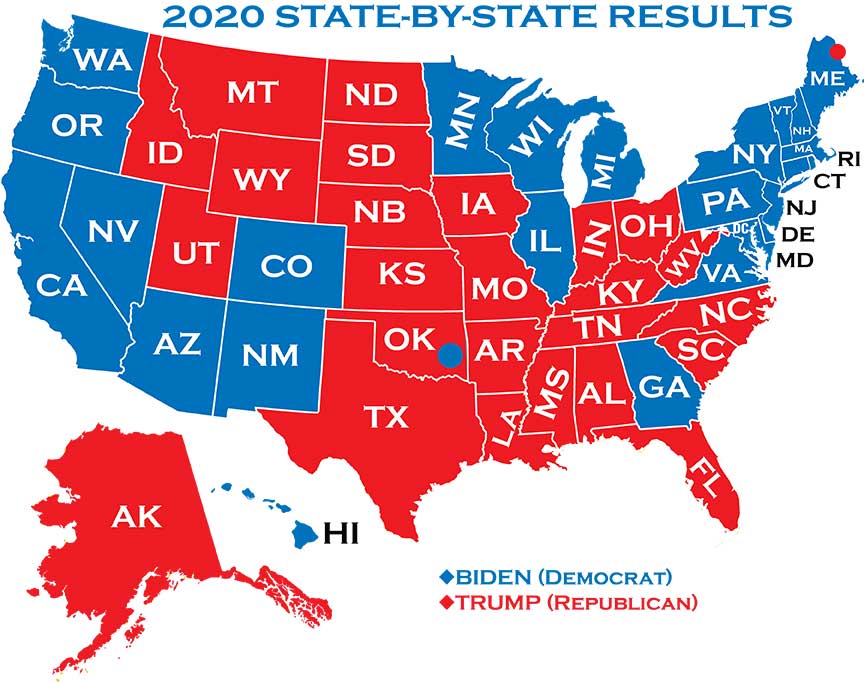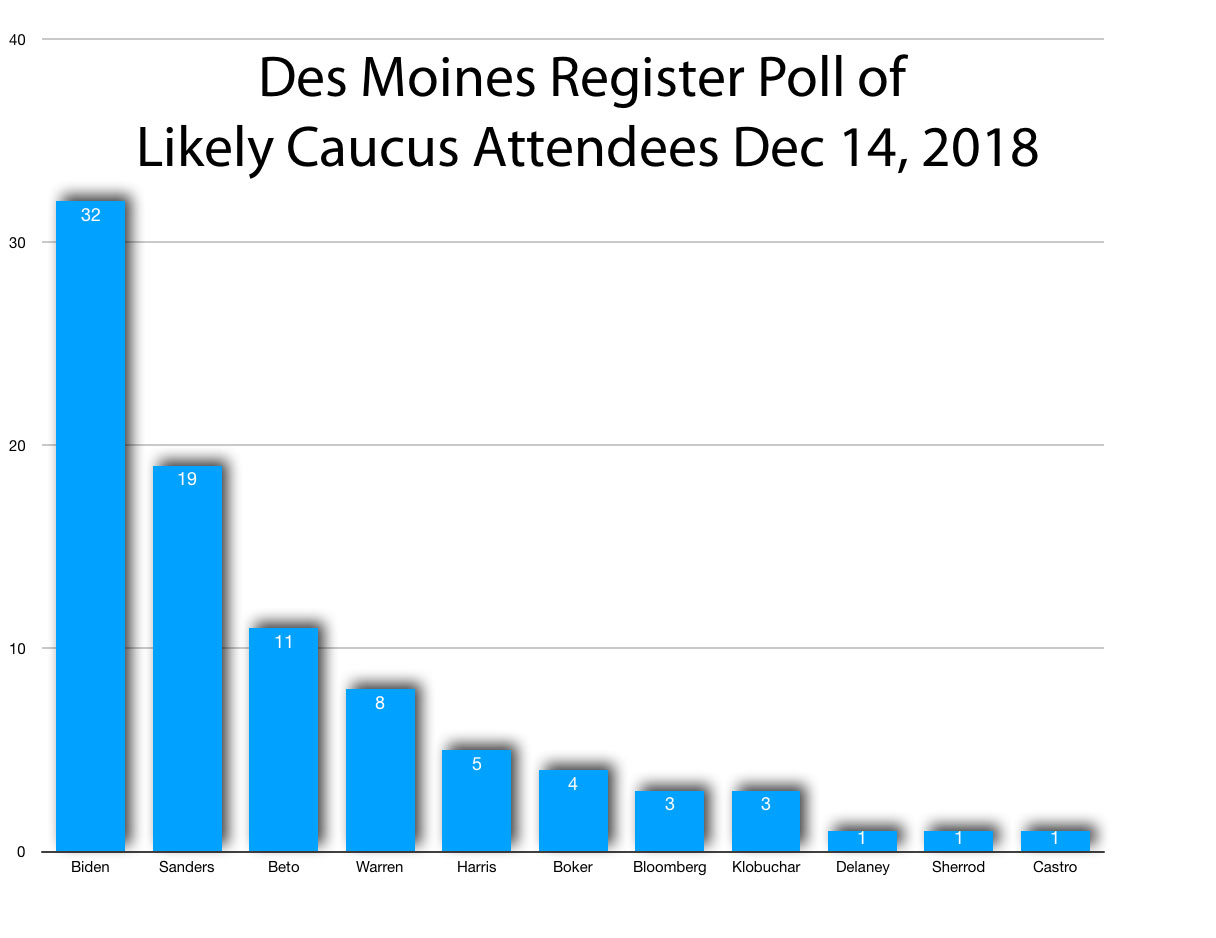The 2020 Elections
Over twenty candidates competed for the Democratic nomination, among which, former Vice President Joe Biden was simultaneously the front-runner and the underdog. Biden was considered the frontrunner, as he consistently polled better against President Trump. However, many, especially in the media, considered Biden "yesterday's news." A majority of the Democratic contenders dropped out before the first primary. Biden lost the primaries in Iowa and New Hampshire but then won the primary in North Carolina. Biden's North Carolina victory came thanks to the overwhelming support of the African American community. This win quickly catapulted Biden to a series of successes in primaries and caucuses on Super Tuesday, which ultimately guaranteed him the nomination.
National polls showed Biden with a consistent lead over President Donald J. Trump, ranging from 4 points to 12 points. Due to the COVID-19 pandemic, the 2020 election was one of the most unconventional in modern American history. Biden did not hold any massive rallies, limiting participation to numbers that would maintain proper social distancing. In contrast, Trump ignored the dangers of the widespread contagion and held many large-scale rallies in the closing two weeks of his campaign.
The candidates were scheduled to challenge each other in a series of three Presidential debates. The first debate was a fiasco for Trump, who interrupted Biden incessantly. Soon after the first confrontation, Trump was diagnosed with COVID-19. Thanks (most likely to the complement of experimental drugs administered to him), the President swiftly recovered and headed back on the campaign trail within ten days. Trump refused to participate in the second scheduled debate, designed to be in a town hall setting. However, Trump did agree to take part in the third planned debate, which became the second encounter. Held after Trump's recovery from COVID-19, the second was considered a closer contest. While there was no clear agreement regarding the victor, a majority of debate watchers seemed to appreciate Biden's call for unity as his closing message.
The Democrats had a financial advantage during the later stages of the 2020 Presidential campaign, out-raising Republicans by a significant margin. Biden's message mostly focused on a series of attacks on the Trump administration's mishandling of the COVID-19 pandemic, combined with a call to work to bring America together. Trump's message was that Biden would "bring the radical left to power," and the allegation "America would not be safe with the radicals who want socialism."
Trump's strategy of holding massive rallies appeared effective in getting out his base. However, Trump lost the suburb vote, which has been key to Republican victories in the past decades. Biden was able to mobilize the minority communities in most parts of the US, which propelled him to surprise victories in both Georgia and Arizona. Nevertheless, Biden did not do as well as polls had projected, seemingly the result of a larger-than-expected turnout for Trump. The 2020 race had the highest turnout for a Presidential election in one hundred years. Both Trump and Biden turned out record numbers of voters. Without any serious third-party candidates (as there had been in 2016), Biden won a decisive victory in the popular vote, defeating Trump by over 7 million votes.
Regarding the 2020 election, one last matter should be noted. Due to the Coronavirus pandemic, most states allowed mail-in voting, many for the first time. Democrats who, by and large, took the pandemic more seriously than Republicans, chose to vote overwhelmingly by mail. Thus, in states that did not allow mail-in votes to be processed until election day, the initial returns favored Trump; and only after all of the legal mail-in ballots were counted did that change. Therefore, it was not until November 7th (four days after election day), when it became clear Biden had won Pennsylvania (and as a result, more than 270 electoral votes), that networks ultimately called the election in favor of Biden.
Trump never conceded the election and claimed to the end that the election had been "stolen." He called for a rally in Washington, on January 6th, 2021, the day Congress was to certify the electoral college results. In a considerable measure due to Trump's incitement, those demonstrators turned into rioters and stormed the Capitol to delay the certification by several hours and to ransack offices. Five people, including a police officer, were killed.



| state | Biden | Trump | Other | Biden | Trump | Other |
| U.S. Total | 67,708,977 | 65,784,397 | 2,442,810 | 49.8% | 48.4% | 1.8% |
| Alabama | 849,624 | 1,441,170 | 32,488 | 36.6% | 62.0% | 1.4% |
| Alaska | 153,778 | 189,951 | 15,801 | 42.8% | 52.8% | 4.4% |
| Arizona | 1,672,143 | 1,661,686 | 53,497 | 49.4% | 49.1% | 1.6% |
| Arkansas | 423,932 | 760,647 | 34,490 | 34.8% | 62.4% | 2.8% |
| California | 11,110,250 | 6,006,429 | 384,192 | 63.5% | 34.3% | 2.2% |
| Colorado | 1,804,352 | 1,364,607 | 87,993 | 55.4% | 41.9% | 2.7% |
| Connecticut | 1,080,680 | 715,291 | 28,302 | 59.2% | 39.2% | 1.6% |
| Delaware | 296,268 | 200,603 | 7,475 | 58.7% | 39.8% | 1.5% |
| District of Columbia | 317,323 | 18,586 | 8,447 | 92.1% | 5.4% | 2.5% |
| Florida | 5,297,045 | 5,668,731 | 101,680 | 47.9% | 51.2% | 0.9% |
| Georgia | 2,473,633 | 2,461,854 | 62,229 | 49.5% | 49.3% | 1.2% |
| Hawaii | 366,130 | 196,864 | 11,475 | 63.7% | 34.3% | 2.0% |
| Idaho | 287,021 | 554,119 | 26,091 | 33.1% | 63.9% | 3.0% |
| Illinois | 3,471,915 | 2,446,891 | 114,938 | 57.5% | 40.6% | 1.9% |
| Indiana | 1,242,413 | 1,729,516 | 61,183 | 41.0% | 57.0% | 2.0% |
| Iowa | 759,061 | 897,672 | 34,138 | 44.9% | 53.1% | 2.0% |
| Kansas | 570,323 | 771,406 | 30,574 | 41.6% | 56.2% | 2.2% |
| Kentucky | 772,474 | 1,326,646 | 37,648 | 36.2% | 62.1% | 1.8% |
| Louisiana | 856,034 | 1,255,776 | 36,252 | 39.9% | 58.5% | 1.7% |
| Maine | 435,072 | 360,737 | 23,652 | 53.1% | 44.0% | 2.9% |
| Maine 1st District | 266,376 | 164,045 | 12,691 | 60.1% | 37.0% | 2.9% |
| Maine 2nd District | 168,696 | 196,692 | 10,961 | 44.8% | 52.3% | 2.9% |
| Maryland | 1,985,023 | 976,414 | 75,593 | 65.4% | 32.2% | 2.5% |
| Massachusetts | 2,382,202 | 1,167,202 | 81,998 | 65.6% | 32.1% | 2.3% |
| Michigan | 2,804,040 | 2,649,852 | 85,410 | 50.6% | 47.8% | 1.5% |
| Minnesota | 1,717,049 | 1,484,048 | 76,023 | 52.4% | 45.3% | 2.3% |
| Mississippi | 539,508 | 756,789 | 17,597 | 41.1% | 57.6% | 1.3% |
| Missouri | 1,253,014 | 1,718,736 | 54,212 | 41.4% | 56.8% | 1.8% |
| Montana | 244,786 | 343,602 | 15,286 | 40.5% | 56.9% | 2.5% |
| Nebraska | 374,583 | 556,846 | 20,283 | 39.4% | 58.5% | 2.1% |
| Nebraska 1st District | 132,261 | 180,290 | 7,495 | 41.3% | 56.3% | 2.3% |
| Nebraska 2nd District | 176,468 | 154,377 | 6,909 | 52.2% | 45.7% | 2.0% |
| Nebraska 3rd District | 65,854 | 222,179 | 5,879 | 22.4% | 75.6% | 2.0% |
| Nevada | 703,486 | 669,890 | 32,000 | 50.1% | 47.7% | 2.3% |
| New Hampshire | 424,921 | 365,654 | 15,607 | 52.7% | 45.4% | 1.9% |
| New Jersey | 2,608,335 | 1,883,274 | 57,744 | 57.3% | 41.4% | 1.3% |
| New Mexico | 501,614 | 401,894 | 20,457 | 54.3% | 43.5% | 2.2% |
| New York | 5,241,957 | 3,250,075 | 119,043 | 60.9% | 37.7% | 1.4% |
| North Carolina | 2,684,292 | 2,758,775 | 81,737 | 48.6% | 49.9% | 1.5% |
| North Dakota | 114,902 | 235,595 | 11,322 | 31.8% | 65.1% | 3.1% |
| Ohio | 2,679,165 | 3,154,834 | 88,203 | 45.2% | 53.3% | 1.5% |
| Oklahoma | 503,890 | 1,020,280 | 36,529 | 32.3% | 65.4% | 2.3% |
| Oregon | 1,340,383 | 958,448 | 75,490 | 56.5% | 40.4% | 3.2% |
| Pennsylvania | 3,459,923 | 3,378,263 | 79,397 | 50.0% | 48.8% | 1.1% |
| Rhode Island | 307,486 | 199,922 | 10,349 | 59.4% | 38.6% | 2.0% |
| South Carolina | 1,091,541 | 1,385,103 | 36,685 | 43.4% | 55.1% | 1.5% |
| South Dakota | 150,471 | 261,043 | 11,095 | 35.6% | 61.8% | 2.6% |
| Tennessee | 1,143,711 | 1,852,475 | 57,665 | 37.5% | 60.7% | 1.9% |
| Texas | 5,259,126 | 5,890,347 | 165,583 | 46.5% | 52.1% | 1.5% |
| Utah | 560,282 | 865,140 | 62,867 | 37.6% | 58.1% | 4.2% |
| Vermont | 242,820 | 112,704 | 11,904 | 66.1% | 30.7% | 3.2% |
| Virginia | 2,413,568 | 1,962,430 | 84,526 | 54.1% | 44.0% | 1.9% |
| Washington | 2,369,612 | 1,584,651 | 133,368 | 58.0% | 38.8% | 3.3% |
| West Virginia | 235,984 | 545,382 | 13,286 | 29.7% | 68.6% | 1.7% |
| Wisconsin | 1,630,866 | 1,610,184 | 56,991 | 49.4% | 48.8% | 1.7% |
| Wyoming | 73,491 | 193,559 | 9,715 | 26.6% | 69.9% | 3.5% |
Major Milestones in the Campaign

 >
>